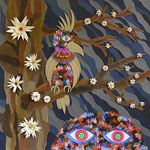When I saw Michael Velliquette’s show in Chelsea, minus-one-degree
chill factor winds blew outside. Inside, the collages surrounded me
like hothouse flowers, as if I had entered a steamy greenhouse.
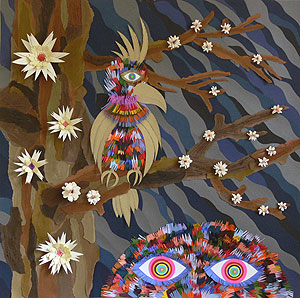
The 12 framed pieces flare with bright
licks of flame in oranges, reds, and yellows, and feature bizarre birds
of the night, wild-eyed beasts and hundreds of tiny human silhouettes
reaching up as if doomed to a Byzantium Hell. The collages point to
Velliquette’s continued ability to transplant the viewer into another
realm made entirely of his own specific mythology.
While at ArtPace,
Velliquette managed a Herculean task: He successfully transformed a
huge room into a magical realm that glimmered with light playing on a
false stream bridged by a Candyland pathway, a realm populated by
curiously high-pitched voices and cardboard rocks. After his ArtPace
show, Velliquette did two more room-sized sculptural installations in
San Francisco and Dallas. Although they are flat works, the collages
effectively demonstrate his proclivity for three dimensions and color.
The identifying characteristics of Velliquette’s work — his rainbow
palette and his enchanting symbolic realms — have undergone here not a
reduction, but more of a distillation.
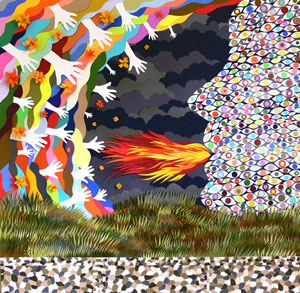
Line alone cannot convey the wonder that Velliquette is
capable of transmitting. He uses an incremental building process that
involves layers and layers of tiny, complex cut paper pieces. In Visitors at the Gate
(2006), 18 colorfully furred, wide-eyed monsters crowd behind a stone
wall with its gate barred shut. The monsters’ furry texture comes from
layers of paper cut with jagged edges. These may elicit the familiar
elementary school action of taking construction paper and cutting lines
along the edge to create a fringe, but Velliquette has executed his
collages with sophistication and intricacy. Each monster is a different
color with variations: The blue one, for example, contains two shades
of blue. Velliquette created their wide open eyes by placing concentric
circles of different colored paper inside one another. The stone wall
demarcates a duller realm, trapping the bright colors inside a dreary
boundary. Velliquette cut the stones from dark and light gray and tan
paper; even the grass bordering the wall is a deadened green. The wall
echoes the care and precision of actual masonry, as each paper stone
has been cut, carefully set and glued into place.

The two distinguishing palettes help to play out
Velliquette’s notion of the mental scenery implied by the show’s title,
The Intuitive Jungle. (As I was looking at the collages, the
funny helium-inflated sounds of the ArtPace installation came back to
me.) The creatures in the collages seem to embody elements of the
psyche, such as fear, paranoia, wisdom or rage. A mythological aspect
pervades all of his work, yet the meanings remain open to the viewer’s
projections.
Velliquette uses colored archival cardstock, the same material used for
scrapbooking. The labor-intensive process involves cutting out minute
shapes that include hands, figures, eyes, branches, stones and flames,
which he then layers to create the collage. Instead of a cubist
approach, as when Pablo Picasso and Georges Braque
used wallpaper, newspaper and other common paper media to build images
by placing various shapes together, Velliquette compares his use of
collage more readily to Henri Matisse and his cut paper works. While
synthetic cubism juxtaposed disparate media to explore the concept of
the object, Velliquette returns the medium to the picture plane as he
builds landscapes using his imaginative flora and fauna.
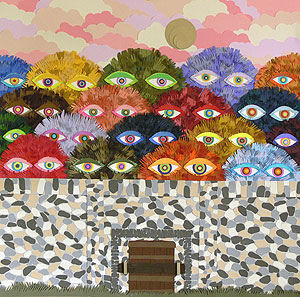
When I visited Velliquette’s San Antonio studio (he moved
to Madison, Wisconsin, in 2007), I saw several of his collages in
process on a huge worktable. Pulled up to the table was a tiny,
uncomfortable-looking stool where, the artist said, he would sit for
hours and cut the many pieces with which he builds his work. The paper
may come from scrapbook stores, but there is nothing cheap, derivative
or predictable about what Velliquette does with it: The paper achieves
an alchemic transformation under his hand. Velliquette builds his
collages from a simple drawing or sketch that details the general focus
of the piece: a huge, wide-eyed monster with a gaping toothed mouth,
say, or a tree with a watchful parrot. The process by which the sketch
changes into the collage reinforces the importance of the
three-dimensional in Velliquette’s work.
In Familiar, a strange, colorful bird sits in a tree
against a night sky. Beneath the tree, peeking up from the bottom edge
of the paper, appears the top of a monster’s head, eyes fully opened,
rising like the sun. Varying shades of torn brown paper comprise the
tree’s bark, giving it a satisfyingly rough texture. Beautiful, white
lotus-like flowers polka-dot the otherwise barren tree’s limbs. The
paper for these flowers, rising above the picture plane, are the most
sculptural element of the collages, though the fringes of the big
monsters and the arms of the tiny figures also bend slightly outward
toward the viewer. All of the collages are framed in a shadowbox format
that allows this sculptural element to flourish. Wavy bands of smoky or
metallic grays, blues and blacks create the night sky. The flux of
color used to create this effect carries with it the sensation of
night, the waves of varying darkness dependent on the viewer’s
movement, and the glimmers of light suggesting the reflections of the
moon and stars.
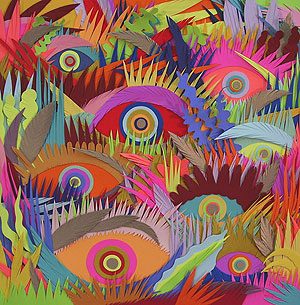
These collages are marked by abundance, in both form and
content. The painstaking process of hand-cutting the shapes does not
burden the work, but rather makes it appear effortless, so effective
and seductive is the transformation. The Great Protector,
showing a huge monster set against a fiery background, contains so many
flames, fringes and figures, they are impossible to count. This implied
abundance seems to incorporate the idea of the universe expressed in
the mythology of the Hindu creator/destroyer god, Shiva. The monster’s
open mouth contains clouds and black drops of rain or tears. I was
reminded of Velliquette’s kitchen window in San Antonio, which looked
out on the profuse, tiny pink blossoms of a coral vine. Velliquette’s
work grows as easily and freely as this vine, native to the harshness
of a South Texas landscape, and its beauty is astounding.
Velliquette's show was at DCKT Contemporary, New York from February 8 through March 10, 2007.
Images courtesy the artist
Wendy Atwell is an art historian living in San Antonio.




